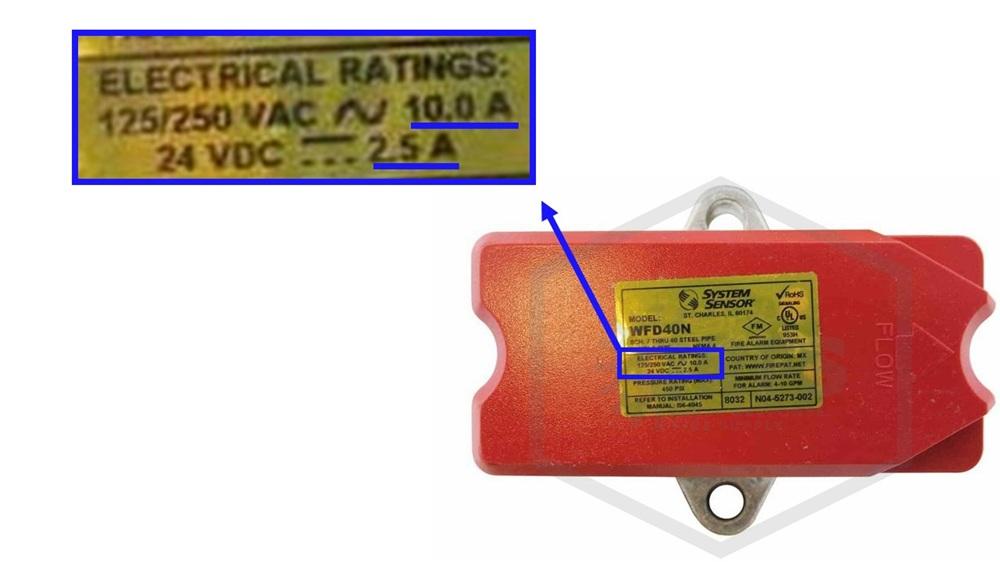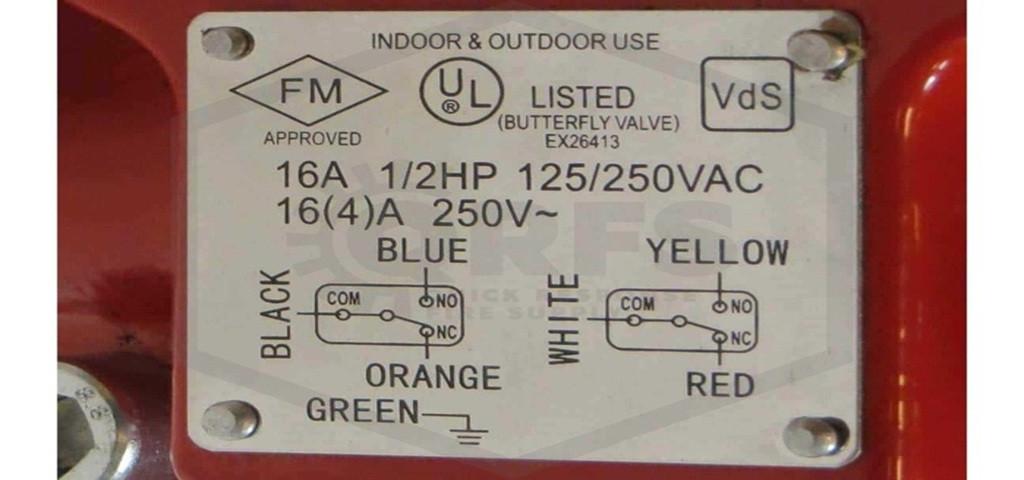A fire sprinkler tamper switch, pressure switch, flow switch, or other supervisory device has specific electrical requirements and limits
Electrical supervisory switches provide valuable monitoring services for fire sprinkler systems. Pressure and flow switches detect when a sprinkler has operated, while valve tamper switches can sound the alarm if a control valve is closed. That last notification is especially crucial, since inappropriate valve closure is the leading cause of sprinkler system failure.
Whether you need to buy a replacement switch or prewired valve, or you’re a sprinkler pro who needs to install switches in a new system, these devices must be compatible with the rest of the circuit. Switch wiring plates and published specs help users determine whether the hardware matches their needs.
Read on to learn more about these electrical details, including:
- Voltage rating, both type and level
- Amp rating, which can be different for different types of voltage
- Ratings for powering a motor or other inductive load
- What do all these numbers mean when choosing a fire protection supervisory switch?
QRFS is your partner for fire protection monitoring devices, including flow switches, pressure switches, add-on valve tamper switches, and butterfly valves with integrated tamper switches.
AC/DC: why voltage matters
One of the first things to note in a wiring guide for a switch is the voltage rating, because a power supply’s voltage should be compatible with the device being used.
Most fire protection switches give two voltage values: one in alternating current (AC) and one in direct current (DC).
Grid power, also called mains power, is alternating current. Fire protection switches are usually rated for both 125V and 250V AC. Circuits in the US and Canada are typically either 120V or 240V AC, so the 125V and 250V ratings (with that added safety buffer) correspond to those circuits. AC voltage can be represented as “VAC” or with a “~” tilde symbol.
DC voltage, on the other hand, typically comes from a battery or from an AC power supply that has been converted to DC. DC voltage ratings can be more varied than AC voltages. DC voltage can be written as “VDC” or a solid bar over three hashed lines: “⎓”

Some switches are rated for both AC and DC power, while others are only set up to handle AC power, so look at the specifications carefully. Additionally, some switches are rated for the same (low) voltage whether they receive AC or DC power. Here’s an example:

It’s also important to know whether the device uses AC or DC power because the amp rating of a switch depends heavily on whether the current is direct or alternating.
Amp ratings tell you how much current a supervisory switch can handle
Amperes, aka “amps” or “A” for short, measure the amount of current that flows through a conductor, whether it’s a cable or a switch. You can think of amps as analogous to the flow rate of water through pipes. Amps measure the flow of electrons.
A major difference is that electron flow creates heat, so different components have a maximum amp rating. Exceeding that amp rating is a fire hazard and can damage electrical components. Breakers and fuses are devices placed in homes, buildings, and some electronics to protect from the danger of excess current. To avoid putting excess current through a switch, the amp rating of the device must always be higher than the actual amps it will experience.
You can calculate the amp load on a switch if you know the voltage of a power source and the power drawn by all the devices controlled by the switch. Power is measured in watts. The formula to find the amps is:
I = P / V, where:
I is current measured in amps
V is voltage measured in volts
P is power measured in watts
All switches have an amp rating, usually published with the corresponding voltage rating, such as seen here:

You’ll notice that the above switch actually has two amp ratings—one for AC voltage and one for DC voltage. This distinction is essential.
The amp rating for DC circuits is often much lower than the rating for AC circuits. This has to do with the need to extinguish arcs when the switch is turned off to break the circuit. When you turn a switch off, electrons still “want” to keep flowing, and an arc can form. In AC circuits, this arc is extinguished very quickly. Because of the way current and voltage alternate direction in a sine wave pattern, there are moments of zero voltage and current that help to extinguish arcs. This doesn’t happen in DC circuits, so switches for DC voltage have low amp ratings, even in the range of milliamps (mA). A milliamp is 1/1000th of an amp!
Some devices have ratings for motors and inductive loads
Although it’s rarely relevant for fire protection monitoring switches, some switch wiring guides contain information related to powering motors or inductive loads like transformers.
When motors are switched on, the “start-up load” will temporarily be much higher than the running load. Thus, a switch powering a motor should be rated for the higher load. Some wiring plates mention the max horsepower of the electrical motor they can power, along with the max voltage and amps. For inductive loads, a lower amp rating is sometimes put in parentheses after the main amp rating—i.e., 16(4)A.

What do all these numbers mean when choosing a fire protection supervisory switch?
There is variation in the listed electrical specifications for tamper switches, flow switches, pressure switches, and other electric supervisory equipment used in fire protection. Some devices have ratings for AC and DC power supplies, while others feature only one, and there can be significant differences in amp ratings. So, how precise do the specs need to be for typical applications?
We can provide two seemingly contradictory but really complementary pieces of guidance:
- Always check with a qualified fire protection professional who has experience installing supervisory switches, local alarm bells, and addressable and conventional fire alarm control panels. They will know exactly which specs are needed for the given installation and system.
- That said, slight differences in electrical specs often aren’t critical, as quality UL Listed and FM Approved supervisory devices can handle most common applications and setups, especially in alarm systems with control panels.
We spoke to a fire alarm system installer who is well-versed in sprinkler system supervisory devices and networking them to control panels or local alarms. He said that he’s never come across a switch that can’t handle standard applications—with a caveat.
In many cases, supervisory devices are networked to and receive electricity via a conventional fire alarm control panel or an addressable fire alarm control panel. In these cases, the voltage that the supervisory switch is exposed to can vary from three to five volts (e.g., when an addressable control panel has a module providing an interface between the panel and the switch) to up to 24 volts (e.g., when a conventional panel is directly connected to a switch). Regardless, the specs of standard supervisory switches can generally handle either of those relatively low amounts of electricity.
However, the pro highlighted a possible scenario with the potential to cause an issue: a separate power source driving something like a local fire alarm bell. In cases where neutral and ground lines are connected to the bell while the hot leg (an ungrounded, current-carrying line) goes through a water flow switch, significantly higher electricity is involved compared to switches connected to control panels.
Regardless:Always consult a fire protection professional who is well-versed in fire sprinkler systems and, when applicable, fire alarm systems and control panels. Electrical requirements are nothing to mess around with, and a pro will verify that a device and its electrical details meet the system’s needs!
Use the right supervisory switches for your fire sprinkler system
Whether it’s a flow switch, a pressure switch, an add-on valve tamper switch, or a butterfly valve with an integrated tamper switch, you must make sure your hardware is compatible with the power demands and voltage of your monitoring circuitry. Fortunately, everything crucial is shown on the switch, enabling checking the amp rating and voltage. Consult with a fire pro to ensure compatibility!
For your sprinkler supervisory needs, check out QRFS’s catalog of flow switches, pressure switches, add-on valve tamper switches, and butterfly valves with integrated tamper switches. If you don’t see exactly what you need, contact us, and we’ll help you get it.
This blog was originally posted at blog.qrfs.com. If this article helped you, check us out on X @QuickResponseFS.


